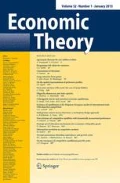Abstract
We extend the Luce model of discrete choice theory to satisfactorily handle zero-probability choices. The Luce mode struggles to explain choices that are not made. The model requires that if an alternative y is never chosen when x is available, then there is no set of alternatives from which y is chosen with positive probability. In our model, if an alternative y is never chosen when x is available, then we infer that y is dominated by x. While dominated by x, y may still be chosen with positive probability, when grouped with a comparable set of alternatives.
Similar content being viewed by others
Notes
A recent growing literature extends the Luce model to capture various behavioral phenomena, but typically requires strictly positive choice probabilities.
A common example in the literature on semiorders is the comparison of coffee with different amounts of sugar. One additional grain of sugar produces an indifferent cup of coffee. But after adding enough grains, one obtains a noticeably sweeter cup.
The paper by Fudenberg et al. (2015) allows for deterministic choices, but does not focus on Luce.
A first draft of our paper focused on the threshold Luce mode, which we define below. We thank an anonymous referee and David Ahn for suggesting that we extend the discussion to cover the general Luce model and the two-stage general Luce model. After we wrote the first version of our paper, which did not include our most general model, Ahumada and Ulku (2017) independently developed the present generalization.
Transitivity and irreflexivity imply asymmetry.
The function c also satisfies the following property. If \(B \subset A\) and \(c(A) \subset B\), then \(c(B)=c(A)\). This property appears in several studies, such as Aizerman and Malishevski (1981).
\(n=2\) is allowed.
Luce IIA implies that for any i, \(p(x_i,A_i)/p(x_{i+1},A_i)= p(x_i, \cup _{j=1}^{n-1}A_j)/p(x_{i+1},\cup _{j=1}^{n-1}A_j)\). So the right hand side becomes \(p(x_1,\cup _{j=1}^{n-1}A_j)/p(x_{n},\cup _{j=1}^{n-1}A_j)\), which is \(p(x_1,A_n)/p(x_n,A_n)\) by Luce IIA again.
To see this consider \(x, y, z \in X\) such that \(x \simeq y\), \(x \simeq z\), and \(z\gg y\) but \(u(z)< u(y)\). Then \(p(x,\{x, y\})= u(x)/(u(x)+u(y))< u(x)/(u(x)+u(z))=p(x,\{x,y,z\})\).
Suppose that \(z_{i} \gg z_{i+1}\) for some i. Then \(d((z_i)_{i=1}^s)\) becomes \(+\infty \), even though \(z_{j+1} \ge z_j\) for some \(j\ne i\). This is not useful to compare the values of intensity. So, by (iii), we restrict when \(z_{i} \gg z_{i+1}\) is allowed: it is allowed only when \(z_{i} \ge z_{i+1}\) for all i.
We appreciate a referee who pointed out the relationship.
See Definition 12 of Sen (1971) to see the relationship between the normality of a choice function and a threshold Luce function.
Otherwise, we have \(x_j\equiv z \gg y \equiv x_{j+1}\), which shows \(u(z)/u(y) \equiv u(x_j)/u(x_{j+1})>1+\alpha \), which is a contradiction.
References
Ahumada, A., Ulku, L.: Luce rule with limited consideration. Math. Soc. Sci. 93, 52–56 (2017)
Aizerman, M., Malishevski, A.: General theory of best variants choice: some aspects. IEEE Trans. Autom. Control 26, 1030–1040 (1981)
Block, H., Marschak, J.: Random orderings and stochastic theories of responses. In: Olkin, I., Ghurye, S.G., Hoeffding, W., Hotelling, H., Madow, W.G. (eds.) Contributions to Probability and Statistics, vol. 2, pp. 97–132. Stanford University Press, Palo Alto (1960)
Brady, R.L., Rehbeck, J.: Menu-dependent stochastic feasibility. Econometrica 84, 1203–1223 (2016)
Cerreia-Vioglio, S., Maccheroni, F., Marinacci, M., Rustichini: Law of Demand and Forced Choice. Tech. rep (2016)
Cerreia-Vioglio, S., Maccheroni, F., Marinacci, M., Rustichini, A.: Multinomial Logit Processes and Preference Discovery: Inside and Outside the Black Box. Mimeo, U. Bocconi, New York (2017)
Echenique, F., Saito, K., Tserenjigmid, G.: The perception-adjusted Luce model. Math. Soc. Sci. 93, 67–76 (2018)
Fishburn, P.C.: Binary choice probabilities: on the varieties of stochastic transitivity. J. Math. Psychol. 10, 327–352 (1973)
Flores, A., Berbeglia, G., Van Hentenryck, P.: Assortment Optimization Under the General Luce Model. Tech. rep (2017)
Fudenberg, D., Strzalecki, T.: Dynamic logit with choice aversion. Econometrica 83, 651–691 (2015)
Fudenberg, D., Iijima, R., Strzalecki, T.: Stochastic choice and revealed perturbed utility. Econometrica 83, 2371–2409 (2015)
Gul, F., Natenzon, P., Pesendorfer, W.: Random choice as behavioral optimization. Econometrica 82, 1873–1912 (2014)
Horan, S.: Random Consideration and Choice. Tech. rep., mimeo, Université du Québeca Montréal (2014)
Jamison, D.T., Lawrence, L.J.: Semiorders and the theory of choice. Econometrica 41, 901–912 (1973)
Luce, R.D.: Semiorders and a theory of utility discrimination. Econometrica 24, 178–191 (1956)
Luce, R .D.: Individual Choice Behavior a Theoretical Analysis. Wiley, New York (1959)
Manzini, P., Mariotti, M.: Stochastic choice and consideration sets. Econometrica 82, 1153–1176 (2014)
Masatlioglu, Y., Nakajima, D., Ozbay, E.Y.: Revealed attention. Am. Econ. Rev. 102, 2183–2205 (2012)
Sen, A.K.: Choice functions and revealed preference. Rev. Econ. Stud. 38, 307–317 (1971)
Author information
Authors and Affiliations
Corresponding author
Additional information
Echenique thanks the National Science Foundation for its support through the Grants SES 1558757 and CNS-1518941. Saito thanks the National Science Foundation for its support through the Grant SES 1558757.
Rights and permissions
About this article
Cite this article
Echenique, F., Saito, K. General Luce model. Econ Theory 68, 811–826 (2019). https://doi.org/10.1007/s00199-018-1145-5
Received:
Accepted:
Published:
Issue Date:
DOI: https://doi.org/10.1007/s00199-018-1145-5




